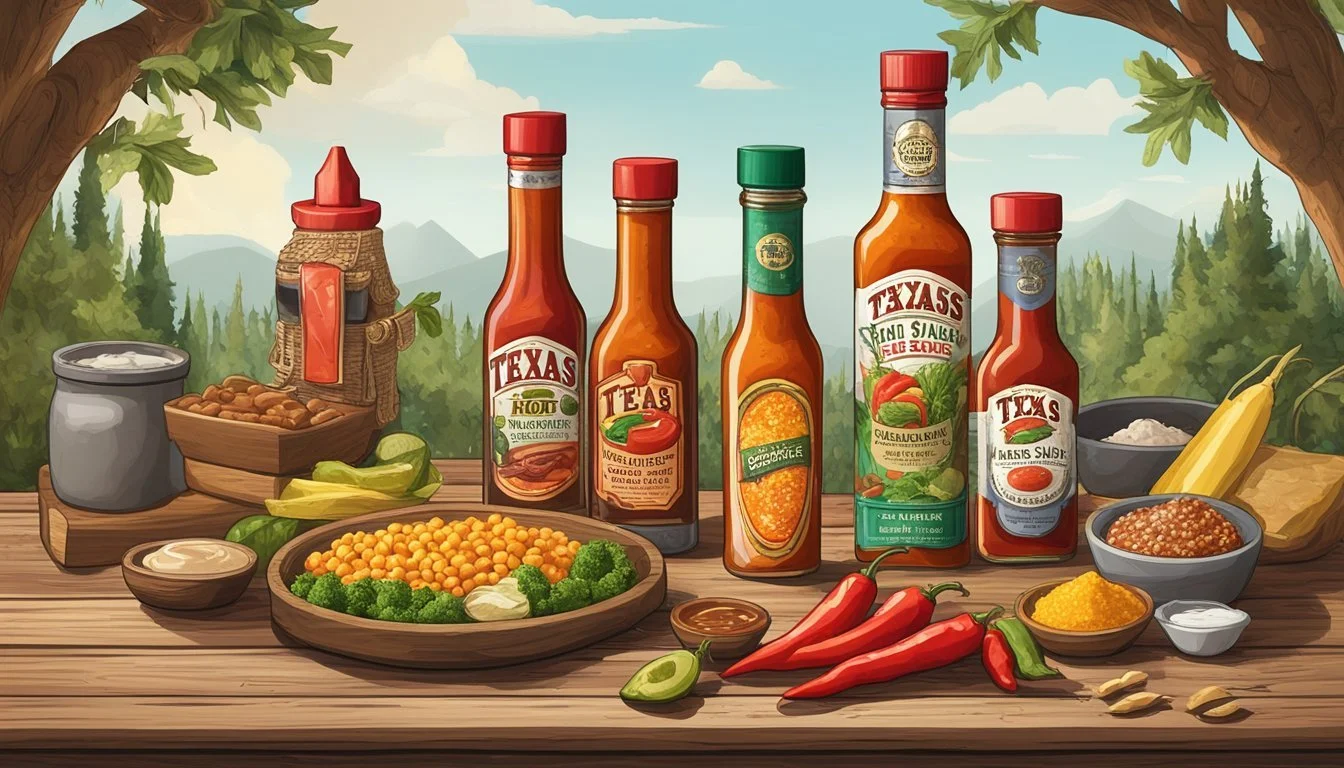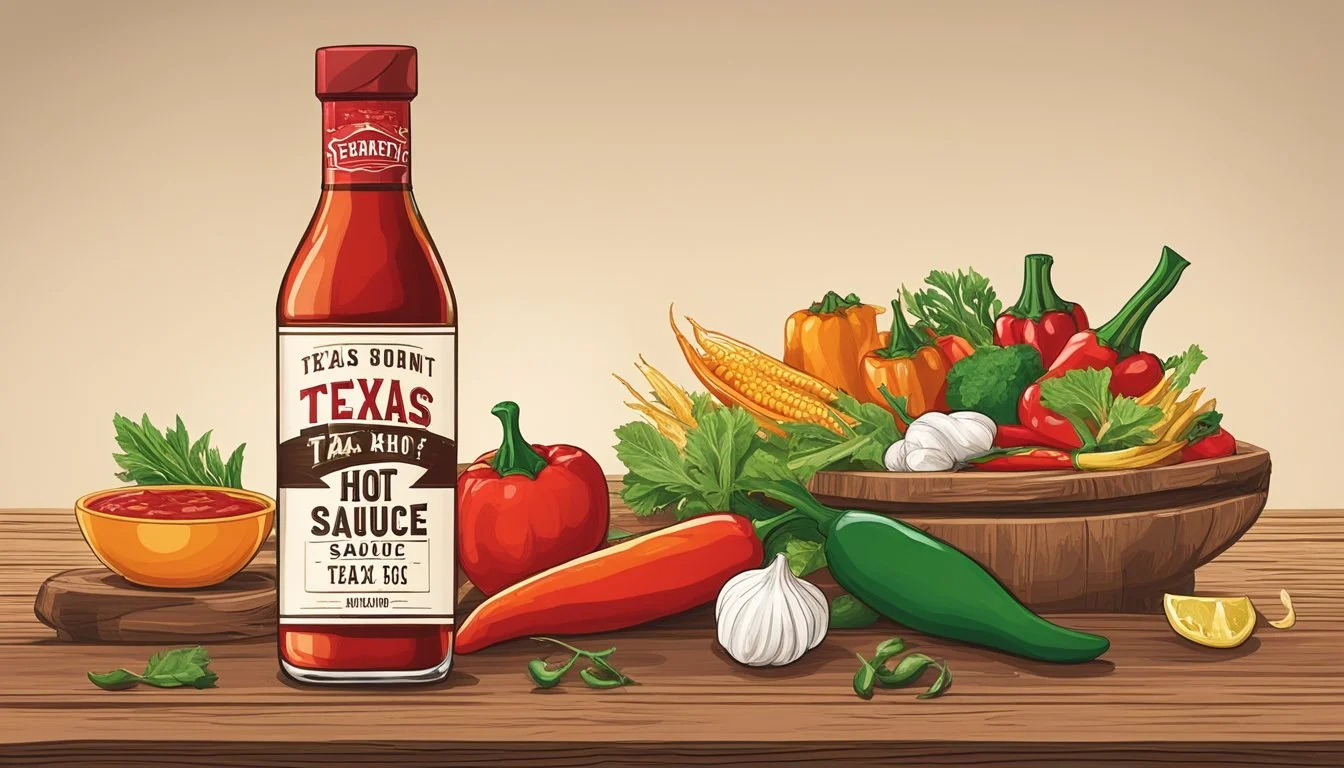How Texas Hot Sauce is Shaping Gourmet Tastes Nationally
The influence of Texas hot sauce on the American gourmet food scene is a fiery testament to the state's culinary contribution. With its roots deeply entrenched in the Tex-Mex tradition, the versatile condiment is now a staple in kitchens and restaurants across America. Artisans and chefs in Texas have mastered the craft of hot sauce production, emphasizing local ingredients and bold flavors. Their creations are not merely about adding heat to a dish but are designed to enhance and complement the depth of flavors.
In the wider gourmet food scene, Texas hot sauces are recognized for their complexity and variety. They often incorporate unexpected elements such as mango and chipotle, standing out with unique flavor profiles that inspire innovative dishes. Texas's commitment to quality is evident in local brands that prioritize all-natural ingredients and partner with regional farmers to ensure freshness. This dedication to authenticity and quality has positioned Texas hot sauces as a significant influence in the national gourmet landscape.
As food enthusiasts search for the next level of flavor experience, Texas hot sauces deliver with their robust, smoky, and sometimes fruity accents. They meet a growing desire for food that excites the palate while offering a taste of Texan culinary heritage. The popularity of events like the Texas Hot Sauce Festival in Houston further highlights the cultural significance of these condiments, revealing a foodie paradise that continues to shape America's gourmet trends.
History of Texas Hot Sauce
Texas hot sauce has become a significant component of the state's cuisine, marking its influence in the broader gourmet food scene. The tradition of adding heat to food using local spices and peppers has evolved over time, intertwining with the state's culinary history to produce the spicy condiments that are now part of Texas's identity.
Origins in Tex-Mex Cuisine
The genesis of Texas hot sauce is deeply rooted in Tex-Mex cuisine, a regional fare that combines Mexican culinary traditions with the taste and ingredients found in the Texas area. Key ingredients typically include native chiles, cumin, and other spices, with an emphasis on the balance of heat and flavor.
Influence of Texas Cuisine on Hot Sauce Evolution
Texas cuisine has shaped the evolution of hot sauce, transitioning it from a simple condiment to an ingredient that enhances the gourmet experience. This evolution mirrors Texas's diverse culinary landscape, where French technique has often met bold Texan flavors, resulting in condiments that highlight the unique Texas palate.
Pioneers of Texas Hot Sauce: Ninfa Laurenzo and Others
Ninfa Laurenzo, a notable figure in Texas culinary history, is one of the pioneers who elevated the status of hot sauce. She founded Ninfa's in Houston, a restaurant that contributed to popularizing Tex-Mex dishes with its own distinctive flavors. Her contributions and others have cemented hot sauce as an essential element of Texas gastronomy, alongside famed establishments that have cherished and promoted the love for this fiery condiment.
Culinary Impact
Texas hot sauce is making its mark on the gourmet food scene with its distinctive heat and complexity. This influence is evident across various culinary approaches, infusing dishes with bold flavors that resonate with both chefs and diners.
Integration in Gourmet Dishes
Chefs in high-end restaurants now frequently incorporate Texas hot sauce into their dishes to deliver layers of flavor. For example, gourmet seafood entrees are enhanced with hot sauce-infused aioli, illustrating how the traditional condiment can be refined for an upscale palate. Appetizers, such as chilled avocado soup, can be livened up with a splash of this fiery sauce to add an unexpected kick.
Fusion with New American Cuisine
New American Cuisine, known for its willingness to embrace diverse culinary elements, now sees Texas hot sauce as a key player in its evolution. This fusion manifests through dishes that pair the sauce with other regional flavors. For instance, grilled pork belly glazes often feature the hot sauce to create a sweet and spicy balance, showcasing the adaptability of Texas hot sauce within contemporary gastronomy.
Boosting Local Culinary Landscape
The local culinary landscape in Texas itself is changing due to the rising popularity of its hot sauce. Texas chefs are leading the charge, boldly innovating with homegrown ingredients that complement the heat of their sauces. The incorporation of hot sauce into classic Texan dishes like slow-cooked brisket and smoked sausages underscores a shift towards more intense and dynamic flavor profiles at the local level.
Types of Texas Hot Sauces
Texas hot sauces, integral to the state's gourmet scene, showcase a diversity of flavors. They vary in heat from mild to fiery, incorporate smoked ingredients for depth, and are crafted by artisans with regional influences from Houston, Austin, and San Antonio.
Regional Variations: Houston vs. Austin vs. San Antonio
For Houston, the hot sauce scene strikes a balance between bold flavors and heat. The city's proximity to the Gulf means that sauces often accompany seafood. In contrast, Austin focuses on innovation, with smoky flavors from chipotle peppers being a common theme. San Antonio hot sauces speak to a rich historical tapestry, displaying a predilection towards traditional Mexican styles that offer both spice and a hint of sweetness.
From Mild to Smoky to Blazing Hot
The spectrum of Texas hot sauces extends from the mild tanginess of a lightly seasoned tomato base to robust, smoky concoctions often made with chipotle or mesquite. At the extreme end are the blazing hot sauces, rich in both heat and flavor, appealing to those with a high tolerance for capsaicin. Heat levels are not arbitrary; for example, Texas Pete Hot Sauce is known to reach up to 3,000 Scoville heat units.
Specialty and Artisanal Creations
Artisans across Texas are handcrafting specialty sauces, utilizing local ingredients and time-tested, small-batch production methods. The result is a remarkable variety of gourmet sauces that contribute uniquely to the culinary landscape. From the sweet and fruity Mango Chipotle Sauce produced by a family business in Converse to the carefully aged and fermented hot sauces that develop complex flavor profiles – specialty and artisanal sauces add a signature Texas flair to dishes.
Ingredients and Flavors
The gourmet food scene in Texas is heavily influenced by the ingredients and flavors inherent in Texas hot sauces. With a focus on locally sourced components, these sauces bring a unique blend of heat and taste to the table.
Key Ingredients in Texas Hot Sauces
Texas hot sauces often start with a base of tomatoes, onions, and of course, chilies. Vinegar is typically added to the mix for its tangy character which balances the heat. Some sauces also incorporate fruits like mango or pineapple for a touch of sweetness to contrast the spiciness.
Tomatoes: Essential for body and sweetness
Onions: Add sharpness and depth
Chilies: The heart of heat; mainly jalapeños and serranos
Vinegar: Provides a tangy kick
Sweeteners: Often fruit-based for complex flavor profiles
Signature Flavors: Serrano, Jalapeño, and Beyond
Texas sauces are known for their use of jalapeño and serrano peppers, delivering a robust heat that is accessible yet intense. Jalapeños bring a moderate spice level and bright crispness, while serranos offer a sharper, more piercing heat. These peppers are the cornerstones of classic Texas hot sauce profiles, setting them apart with their distinctive flavors.
Jalapeño Peppers: Medium heat, vibrant flavor
Serrano Peppers: Higher heat, more intense bite
Local Sourcing: The Freshness Factor
Locally sourced ingredients play a critical role in the quality of Texas hot sauces. Many producers work closely with local farmers to obtain the freshest jalapeños, serranos, and other produce. This not only supports the local economy but also ensures the freshness of the sauce, which is paramount in achieving the bold flavors Texas hot sauce is known for.
Local Farmers: Provide fresh, quality ingredients
Fresh Produce: Ensures peak flavor and heat
Market Trends and Consumer Preferences
The Texas hot sauce market is experiencing a dynamic shift as consumer demand surges and dietary preferences evolve, influencing the gourmet food scene notably.
Rise in Popularity: Sales and Consumer Demand
Texas hot sauces have seen a significant increase in sales, with consumer demand fueled by an appetite for bold and diverse flavors. In America, hot sauces are now a staple in kitchens and restaurants alike, appealing to a broad demographic that includes young adults and culinary enthusiasts who crave a spicy kick. Sales of hot sauces have become indicative of this trend, as they continue to climb both in general markets and within the gourmet food sector.
Hot Sauce and Dietary Trends: Vegan, Paleo, Gluten-Free
Vegan: Many Texas hot sauces align with vegan diets, focusing on plant-based ingredients without compromising on the heat.
Paleo: The growth of the paleo movement has encouraged hot sauce producers to create products with simple, whole-food ingredients that exclude grains and processed sugars.
Gluten-Free: A rising number of consumers demand gluten-free options, and Texas hot sauces typically meet this need by nature of their traditional recipes, which predominantly consist of peppers, vinegar, and spices.
People's Choice: Ranking Texas Hot Sauces
Texas hot sauces are known for their distinct flavor profiles, with a variety of options ranking high on consumers' preference lists. Local productions have gained popularity, often featuring unique ingredients such as local peppers and regional spices that cater to those seeking an authentic Texan taste experience. People's choice awards and taste tests frequently feature Texas brands, solidifying the state's reputation as a hub for high-quality, flavorful hot sauces.
Texas Hot Sauce in Popular Culture
Texas hot sauce has permeated the gourmet food scene, cementing its place in community events, music festivals, and state fairs. It is not just a condiment; it represents a vibrant part of Texas culture and cuisine.
Food Trucks and Festivals: Community Engagement
Food Trucks: These mobile eateries have become ambassadors of Texas hot sauce, often featuring menus that showcase inventive uses of this spicy condiment. They serve as culinary testing grounds for new and bold flavor combinations, making hot sauce more accessible to the public.
Festivals: Events like the Texas Hot Sauce Festival in Houston highlight small-batch and exclusive sauces. These gatherings foster community engagement, allowing artisans to share their passion for hot sauce with eager attendees.
Music and Food: The Live Music Connection
Live Music Events: Often, these events serve Texas cuisine with a side of live entertainment, where hot sauce is as commonplace as amplifiers and guitars. It enhances traditional festival foods, creating a sensory experience of sound and spice.
Connection with Food: At these events, the interplay of rhythm and taste elevates the dining experience. Hot sauce's versatility is showcased in food stalls and stands, paired with everything from tacos to barbecue.
State Fair of Texas: A Cultural Phenomenon
Showcasing Texas Cuisine: The State Fair of Texas is an annual celebration where hot sauce takes the stage. Traditional Texas foods infused with hot sauce are featured, displaying the deep-rooted heritage of this spicy tradition.
Community Impact: The fair serves as a massive platform for local producers to introduce their hot sauces to a wider audience, fostering a sense of community pride in Texas-made products.
Production and Business
The hot sauce industry in Texas is a dynamic mix of innovative production methods, business acumen, and strategic expansion. This section explores the distinct facets from grassroots entrepreneurial efforts to the global footprint of Texas hot sauce.
Local Entrepreneurs and Hot Sauce Startups
Texas's robust business environment is fertile ground for hot sauce entrepreneurs. In cities like Austin and Houston, local farmers often pair with small businesses, creating a supply chain that fosters startup growth. Local farmers are crucial in providing fresh ingredients, which startups emphasize to distinguish their products in a crowded market.
Scaling Production: Challenges and Achievements
As Texas hot sauce companies move from local markets to larger scale production, they encounter challenges including maintaining ingredient quality and managing logistics. Successful brands tackle these by streamlining production processes while staying true to their artisanal roots. For example, sourcing peppers directly from local farmers allows businesses to scale up without compromising on the distinctive flavors associated with Texas.
Beyond Texas: National and International Reach
The influence of Texas hot sauce extends well beyond state borders, reaching into markets like New York, Louisiana, and California, and even as far as Maine and Virginia. The entrepreneurs behind these products have navigated complex distribution networks to deliver Texas's fiery concoctions to an international audience, establishing the state as a formidable player in the global hot sauce market.
Consumption and Usage
In the gourmet food scene, Texas hot sauce is a versatile condiment that enhances a wide variety of dishes, from classic Texan breakfast tacos to unexpected desserts like ice cream.
Traditional and Innovative Pairings
Texas hot sauces, known for their spicy kick, have found traditional harmony with Central Texas-style smoked meats (What wine goes well with smoked meats?) and are a staple in tortilla factories across the state. They meld particularly well with guacamole, offering a bold twist to this creamy avocado dip. Yet, chefs are also experimenting with hot sauce in innovative pairings, such as with pastries, where the heat adds an unexpected yet delightful accent.
Serving Suggestions: Breakfast Tacos to Ice Cream
Breakfast Tacos: A drizzle of Texas Pete or a similar local hot sauce over breakfast tacos wrapped in freshly made tortillas can invigorate the morning meal.
Ice Cream: Dessert enthusiasts in Texas are even incorporating spicy sauces with sweets; a dab of hot sauce over vanilla ice cream creates a surprisingly pleasant contrast.
Toppings, Marinades, and More: Versatility in Use
As a topping, a splash of Texas hot sauce on burgers at a barbecue near the Alamo brings an authentic Texan flavor. Meanwhile, enthusiasts use Texas hot sauces as marinades, lending a piquant depth to both meats and vegetables alike. Its versatility in use makes hot sauce a dynamic player in the culinary game, proving it's not just an additive, but a key ingredient that transforms the ordinary into extraordinary.
Future Outlook
The Texas hot sauce landscape is poised for a dynamic evolution, with new flavor innovations and an emphasis on sustainability shaping its fusion with gourmet food trends.
Innovation and the Next Big Flavor
The search for new flavors is relentless, with artisanal makers experimenting with a variety of peppers and ingredients to create unique hot sauce combinations. These innovative flavors are being designed to complement New American cuisine, offering a complex heat profile that elevates dishes beyond just a spicy kick.
Expanding Palates and Texas Hot Sauce
With a trend towards diverse and bold flavors, Texas hot sauces are becoming a staple in kitchens across the nation. Expanding palates have welcomed the integration of versatile hot sauce flavors that can transform a dish, blending well with everything from breakfast tacos to upscale dining experiences.
Sustainable Practices and the Artisanal Movement
The artisanal movement has intertwined itself with sustainable practices, resulting in a surge of hot sauce producers who prioritize eco-friendly production methods. By focusing on sustainable ingredients and local sourcing, these producers are not only reducing their impact on the environment but also supporting local economies and enriching the overall quality of their hot sauces.








